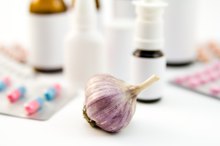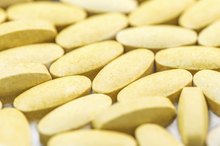What does fact checked mean?
At Healthfully, we strive to deliver objective content that is accurate and up-to-date. Our team periodically reviews articles in order to ensure content quality. The sources cited below consist of evidence from peer-reviewed journals, prominent medical organizations, academic associations, and government data.
- Kiang Wu Hospital: Study on Povidone Iodine
- Kiang Wu Hospital: Study on Povidone Iodine
- Mayo Clinic: Lactobacillus Acidophilus Dosing
The information contained on this site is for informational purposes only, and should not be used as a substitute for the advice of a professional health care provider. Please check with the appropriate physician regarding health questions and concerns. Although we strive to deliver accurate and up-to-date information, no guarantee to that effect is made.
Bacterial Vaginosis Remedies
Bacterial vaginosis is an infection caused by an unhealthy ratio of good to bad bacteria in the vaginal flora. Symptoms vary with bacterial vaginosis, but some of the indications may include white or gray discharge, odor, cramps and itching and irritation. Remedies consist of using prescription and homemade resources, but the following remedies are self-administered in the comfort of the home and do not require a prescription.
If you are experiencing serious medical symptoms, seek emergency treatment immediately.
Iodine
Povidone-iodine, sold as Betadine in retail pharmacies, can relieve symptoms of bacterial vaginosis and even cure some of the most resistant cases, including recurrent episodes. Several studies show that povidone iodine is a useful remedy for treating bacterial infections. One study, conducted at the Kiang Wu Hospital, Department of Obstetrics and Gynecology in Macau, treated participants with symptoms of bacterial vaginosis to a seven-day course of povidone-iodine solution 1. Results showed that povidone-iodine solution cured 73.3 percent, while the remaining 16.7 percent had significant improvement in symptoms.
Make a povidone-iodine solution and use twice a day for at least one week. Combine ½ tsp. of povidone-iodine with one cup of water 1. Use the douche solution twice a day for up to two weeks for persistent, recurrent infections.
- Povidone-iodine, sold as Betadine in retail pharmacies, can relieve symptoms of bacterial vaginosis and even cure some of the most resistant cases, including recurrent episodes.
Lactobacillus Supplements
Vinegar Douche Benefits
Learn More
Lactobacillus acidophilus is good bacteria and a welcomed inhabitant of the vaginal flora 2. The good bacteria feed on the bad bacteria to keep the body from getting infections. Supplements containing Lactobacillus, particularly the L. acidophilus species, can restore the healthy balance of bacteria in the flora 2. The University of Maryland Medical School (UMMS) recommends taking an oral supplement containing at least 1 to 2 billion live cultures each day for up to two weeks, or inserting the supplement directly into the vaginal cavity. For internal applications, use a sanitary napkin for added protection during the course of treatment.
The Mayo Clinic recommends using liquid L. acidophilus preparations on the vulva to relieve symptoms of itching and irritation on the external regions. When conditions improve, switch to lower-dose supplements that contain at least 10 million live cultures. Continue using liquid L. acidophilus as needed to relieve occasional discomfort.
- Lactobacillus acidophilus is good bacteria and a welcomed inhabitant of the vaginal flora 2 recommends taking an oral supplement containing at least 1 to 2 billion live cultures each day for up to two weeks, or inserting the supplement directly into the vaginal cavity.
- The Mayo Clinic recommends using liquid L. acidophilus preparations on the vulva to relieve symptoms of itching and irritation on the external regions.
Probiotic Foods
Certain foods can treat and prevent bacterial vaginosis. Foods that contain good bacteria, also called probiotic foods, can remedy current infections and maintain a healthy ratio of good to bad bacteria in the body to prevent recurrent infections. Some of the food sources containing live cultures include:
- garlic
- bananas
- yogurt
- sauerkraut
- pickles
- wine
- cheese
- bread
- chocolate
However, some foods, such as chocolate, may contain a high content of sugar. Since unwelcomed bacteria thrive on sugar, choose low-sugar or sugar-free options to reap the full benefits of eating probiotic foods.
- Certain foods can treat and prevent bacterial vaginosis.
- Foods that contain good bacteria, also called probiotic foods, can remedy current infections and maintain a healthy ratio of good to bad bacteria in the body to prevent recurrent infections.
Folk Medicine
How to Use Alka Seltzer to Get Rid of Yeast Infections
Learn More
Regular use of douches can disrupt the natural balance of healthy bacteria in the vagina. An occasional douche, particularly in cases of bacterial infections, cleanses the vaginal cavity and removes excess discharge. For recurrent episodes of bacterial vaginosis, a douche may only offer temporary relief of symptoms. For a homemade douche, combine 1 tbsp. baking soda or 2 tbsp. distilled vinegar with one cup of room-temperature water.
Vinegar baths provide relief for many women. The benefits of a vinegar bath include mild cleansing and irritation relief. To prepare a vinegar bath, mix one cup of vinegar into lukewarm bathwater and soak for up to 20 minutes. Take the vinegar bath as needed, but no more than twice a day as baths can cause dry skin.
For a natural remedy in the form of a suppository, dip a tampon in unsweetened, plain yogurt and insert into the vaginal cavity. Replace three times a day. Alternatively, use one-fourth of a garlic clove as a suppository. Consider using the suppositories for overnight treatment or use during the day with a sanitary napkin.
- Regular use of douches can disrupt the natural balance of healthy bacteria in the vagina.
- For a natural remedy in the form of a suppository, dip a tampon in unsweetened, plain yogurt and insert into the vaginal cavity.
Related Articles
References
- Kiang Wu Hospital: Study on Povidone Iodine
- UMMS: Lactobacillus Acidophilus
- Miller EA, Beasley DE, Dunn RR, Archie EA. Lactobacilli dominance and vaginal pH: why is the human vaginal microbiome unique?. Front Microbiol. 2016;7:1936. doi:10.3389/fmicb.2016.01936
- Lobo, RA, Gershenson, DM, Lentz, GM, Valea, FA. Comprehensive Gynecology. New York, NY: Elsevier Health Sciences; 2016.
- Heczko PB, Tomusiak A, Adamski P, et al. Supplementation of standard antibiotic therapy with oral probiotics for bacterial vaginosis and aerobic vaginitis: a randomised, double-blind, placebo-controlled trial. BMC Womens Health. 2015;15:115. doi:10.1186/s12905-015-0246-6
- De Alberti D, Russo R, Terruzzi F, Nobile V, Ouwehand AC. Lactobacilli vaginal colonisation after oral consumption of Respecta(®) complex: a randomised controlled pilot study. Arch Gynecol Obstet. 2015 Oct;292(4):861-7. doi:10.1007/s00404-015-3711-4.
- Murina F, Graziottin A, Vicariotto F, De Seta F. Can Lactobacillus fermentum LF10 and Lactobacillus acidophilus LA02 in a slow-release vaginal product be useful for prevention of recurrent vulvovaginal candidiasis?: A clinical study. J Clin Gastroenterol. 2014 Nov-Dec;48 Suppl 1:S102-5. doi:10.1097/MCG.0000000000000225.
- Vodstrcil LA, Walker SM, Hocking JS, Law M, Forcey DS, Fehler G, Bilardi JE, Chen MY, Fethers KA, Fairley CK, Bradshaw CS. Incident bacterial vaginosis (BV) in women who have sex with women is associated with behaviors that suggest sexual transmission of BV. Clin Infect Dis. 2015 Apr 1;60(7):1042-53. doi:10.1093/cid/ciu1130.
- Boskey ER, Cone RA, Whaley KJ, Moench TR. Origins of vaginal acidity: high D/L lactate ratio is consistent with bacteria being the primary source. Hum Reprod. 2001 Sep;16(9):1809-13.
- Boskey ER, Telsch KM, Whaley KJ, Moench TR, Cone RA. Acid production by vaginal flora in vitro is consistent with the rate and extent of vaginal acidification. Infect Immun. 1999 Oct;67(10):5170-5.
- Recine N, Palma E, Domenici L, Giorgini M, Imperiale L, Sassu C, Musella A, Marchetti C, Muzii L, Benedetti Panici P. Restoring vaginal microbiota: biological control of bacterial vaginosis. A prospective case-control study using Lactobacillus rhamnosus BMX 54 as adjuvant treatment against bacterial vaginosis. Arch Gynecol Obstet. 2015 Jul 5.
- Taha TE, Hoover DR, Dallabetta GA, Kumwenda NI, Mtimavalye LA, Yang LP, Liomba GN, Broadhead RL, Chiphangwi JD, Miotti PG. Bacterial vaginosis and disturbances of vaginal flora: association with increased acquisition of HIV. AIDS. 1998 Sep 10;12(13):1699-706.
Writer Bio
Cheryl Myers has has a master's degree from Saint Leo University and currently writes for several publications including Fit Pregnancy, Guideposts and Parent's Magazine.









